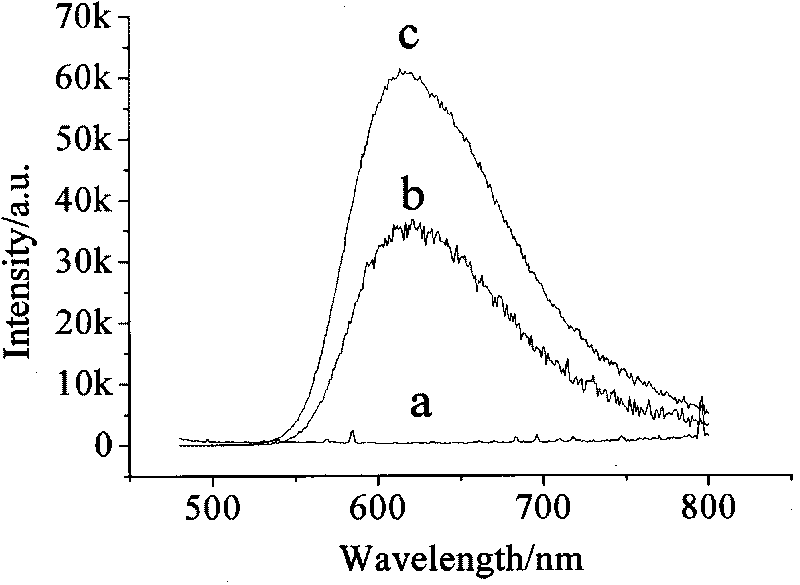Preparing method of electrochemiluminescence immunosensor
A luminescence immunity and electrochemistry technology, applied in the field of preparation of nanometer immunolabels, can solve the problems of short service life, poor stability, easy leakage of modified substances, etc., and achieve the effect of maintaining chemical properties, preventing leakage and improving sensitivity
- Summary
- Abstract
- Description
- Claims
- Application Information
AI Technical Summary
Problems solved by technology
Method used
Image
Examples
Embodiment 1
[0023] A preparation method of electrochemiluminescence immunosensor, the preparation steps are: SiO 2 Preparation of @Ru microspheres: Mix 7.5mL cyclohexane, 1.8mL n-hexanol and 1.77mL Tween-80 evenly, then add 340μL 5mg / mL Ru(bpy) 3 2+ The aqueous solution was uniformly stirred at room temperature for 30 minutes to form a stable water-in-oil system, and then 100 μL TEOS and 60 μL NH 3 ·H 2 O to initiate the polymerization reaction, and continue to stir the reaction at room temperature for 20h. After the reaction is completed, add 5mL acetone to the system to separate and precipitate the nanoparticles from the water-in-oil system, and then centrifuge at 8000r / min for 10min. See the formation of an orange-yellow precipitate, discard the supernatant, wash the precipitate several times with absolute ethanol and water, and fully remove the surfactant TEOS and the Ru(bpy) adsorbed on the surface of the nanoparticles 3 2+ , get SiO 2 @Ru microspheres; Preparation of nano-immun...
Embodiment 2
[0025] Preparation of Ab1-MUA / MU-Au modified electrode
[0026] The gold wire electrode was boiled in 2M KOH for 2h and washed. Put it into 30μL 2.5mM MUA and 30μL 7.5mM MU(V MUA / V MU =1:3) in the mixed solution for 10h. Obtain MUA / MU modified gold wire electrode and immerse in TNTU(o-(5-norbornene-2,3-dicarboximido)-N,N,N',N'-tetramethyluronium tetrafluoroborate ) in the activation solution for 15 minutes, rinsed, and put into 100 μL anti-AFP solution for 1 hour. After rinsing, put it into 100 μL of BSA (1 wt%) solution for 30 min to block the non-specific binding site, and obtain anti-AFP (Ab1) modified gold wire electrode (Ab1-MUA / MU-Au).
[0027] AFP antibody modified SiO2@Ru microspheres
[0028] 2mL SiO2 2 Dilute @Ru with ethanol to 6 mL, add 400 μL APTS and stir for 30 min, centrifuge, wash with water and ethanol several times to remove remaining APTS, and obtain APTS-modified SiO 2 @Ru. The above-mentioned nanoparticles were stirred and reacted with 5 mL of glu...
Embodiment 3
[0033] Electrochemiluminescence detection:
[0034] 1) Optimization of test conditions:
[0035] a)C 2 o 4 2- As an important reactant, its concentration has a great influence on ECL. With other conditions unchanged, the ECL signal value increases with C 2 o 4 2- The increase of the concentration first gradually increased and then reached a plateau. in C 2 o 4 2- When the concentration is small, the magnitude of the ECL signal is mainly controlled by C 2 o 4 2- concentration, so as C 2 o 4 2- Concentration increases proportionally; when C 2 o 4 2- When the concentration increases to a certain level, the magnitude of the ECL signal is mainly controlled by the constant SiO in the optimized system 2 @Ru Concentration, thus the platform. Final optimization C 2 o 4 2- The concentration is 3mmol / L.
[0036] b) Antigen incubation time: As the incubation time increases, the ECL signal increases and reaches a plateau after an incubation time of 30 minutes, and t...
PUM
 Login to View More
Login to View More Abstract
Description
Claims
Application Information
 Login to View More
Login to View More - R&D
- Intellectual Property
- Life Sciences
- Materials
- Tech Scout
- Unparalleled Data Quality
- Higher Quality Content
- 60% Fewer Hallucinations
Browse by: Latest US Patents, China's latest patents, Technical Efficacy Thesaurus, Application Domain, Technology Topic, Popular Technical Reports.
© 2025 PatSnap. All rights reserved.Legal|Privacy policy|Modern Slavery Act Transparency Statement|Sitemap|About US| Contact US: help@patsnap.com



